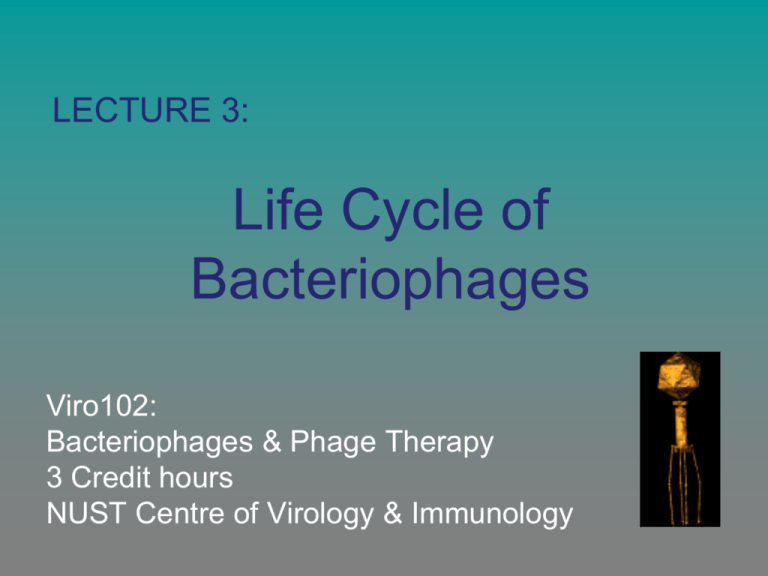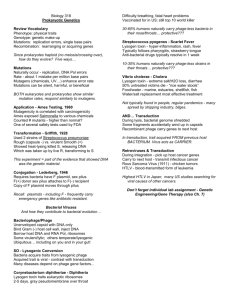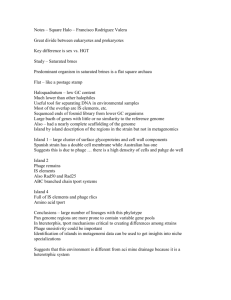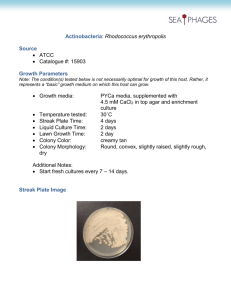Life Cycle of Bacteriophages
advertisement

LECTURE 3: Life Cycle of Bacteriophages Viro102: Bacteriophages & Phage Therapy 3 Credit hours NUST Centre of Virology & Immunology Life Cycle of Bacteriophages Consists of the following steps 1. 2. 3. 4. 5. 6. Adsorption Penetration Replication Maturation Release Reinfection 1. Adsorption Bacteriophages attach to specific receptors on bacterial cell through tail fibers. Receptors include: o LPS, Proteins, Teichoic acids, Flagella, Pilli. Examples: o lambda phage (λ) infects E. coli K12 by J protein (tail fiber) attachment to lamB gene product (host cell wall). o T4 Phage attaches to LPS on E. coli O157:H7 (host cell wall) through tail fibers. o Phage Cbk binds to pilli on Caulobacter crescentus. A-1 Coliphage T-1 attached to bacterial cell wall Cont’d Tail fibers & host cell recptors linked by weak interactions & this association is reversible. Once the host has been recognized, more tail fibers make contact & the base plate settles down. Base plate converts reversible attachment into irreversible 2. Penetration Irreversible attachment induces conformational changes in the contractile sheath & tail, causing the genome to move into the hollow tube. Entry hole for genome in cell wall made by o Enzyme released by the virus (lysozyme). o Or Contractile sheath, itself. Only the viral genome enters the host cell leaving the protein coat of the phage outside. 3. Replication Once Inside the cell, a bacteriophage decides between: o Lytic life cycle: Intracellular replication of phage followed by progeny release. o Lysogenic life cycle: Phage genome integrates into the bacterial genome or exists as a free plasmid in the host cell replicating with it without harming it. Genome Organization Early genes Expression seen in within 2 min after infection Helps phage in taking over host cell E.g. modification of sigma (σ) factor of Host RNA polymerase Middle genes 5 min after infection Products of these genes help in the replication of the phage genome Late genes Direct the synthesis of capsid proteins & assembly of phage Decision between LYTIC or LYSOGENIC cycle Repressor Protein LYSOGENIC CYCLE Activator Protein LYTIC CYCLE LYSOGENIC CYCLE 1. Temperate Phage (High repressor protein) Lysogenic Life Cycle The phage that can undergo lysogenic life cycle is Temperate phage. The phage inside the cell becomes inactivated that is it does not express its genes When the bacterial cell divides into two, the phage is transferred into both daughter cells Cont’d This sort of relationship between the host bacterial cell and the virus is called Lysogeny o Phage = Prophage o Host cell = Lysogen Surface proteins of the host are changed so there is no super infection. This is known as Super infection immunity. Cont’d Prophage can exist in 2 forms o Integrated into the host genome. o Circularized form. Temperate phages have a gene int that encodes an enzyme “integrase”. This is responsible for integration of phage genome into host genome. Integration through Site specific recombination. Site Specific Recombination Cont’d Hostile conditions (UV exposure, desiccation ionizing radiation etc) can cause excision of the viral genome and termination of lysogeny, a process called induction. Lytic life cycle starts after induction of prophage. When a cell becomes lysogenized, occasionally genes carried by the phage get expressed in the cell. These genes can change the properties of the bacterial cell. This process is known as lysogenic conversion or phage conversion. 4. Maturation Early genes Middle genes Late genes 1. Phage structural proteins 2. Proteins that help in phage assembly without becoming part of phage 3. Proteins involved in cell lysis 5. Release Assembled phages directs production of an enzyme that breaks down the bacteria cell wall and allows fluid to enter. Enzymes may include: o Endolysin o Holin This results in cell bursting or lysis; The new viruses are then free to infect other cells Re-infection An average of 50 to 200 phages may be produced per infected bacterium (max 1000) Bacteria always exist in the form of colonies. Phages released from one cell can easily penetrate another cell in the surrounding. In labs, plaque observations are done based on this same principle. The average yield of phages per infected bacterial cell is known as burst size. Bacterial Defense System Possibility of mutations of cell surface receptors Restriction enzymes & RE site o Cut the viral DNA o Protect themselves by methylation of their own genome THANKS






